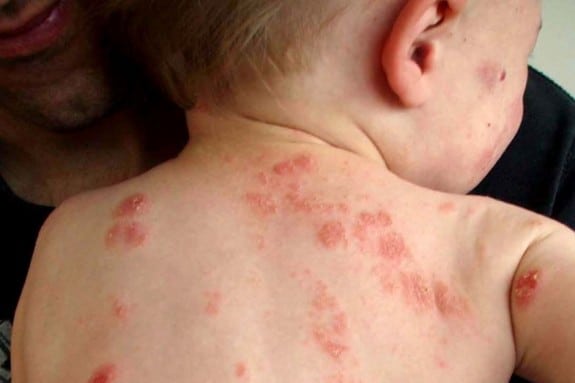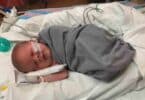Eczema (also known as atopic dermatitis) is a condition that causes the skin to become red, irritated and inflamed. For adults, it’s an awful thing to live with, but for a child who is still growing and learning, it can make everything all the more confusing for them, which only increases their suffering. But researchers believe that they may have found an effective treatment that may very well cure eczema in children.

Image via Eczema Association Australia
“Wet wrap therapy,” consists of dressing and wrapping the child in wet clothing. The theory is that these wet clothes will help to heal their irritated and inflamed skin. The theory was first spoke of in 1987 by a researcher named Noreen Nicol. The new study has been published in the Journal of Allergy and Clinical Immunology. Researchers working at National Jewish Health in Denver, Colorado decided to test the therapy out, and they found that the wet wraps do indeed produce profound results on the children’s skin.
It seems that this research comes at a perfect time, as more children than ever are being diagnosed with eczema, with the numbers increasing three times over since the 1970s, according to information provided by the Cleveland Clinic. Lead study researcher Dr. Mark Boguniewciz, an immunologist and pediatric allergist at National Jewish Health says, “Eczema is not only a big problem in this country, but a huge global health problem. When you look at the numbers, a national health survey of children found the prevalence was up to 18 percent, and in some places it’s over 30 percent. Those are big numbers.”
For years, the typical treatment for those at the mild end of the eczema spectrum was topical steroids or certain moisturizers. For patients at the severe end, oral corticosteroids and potent immuno-suppressants are prescribed. These treatments are considered safe and often prove to be effective in treating the condition. However, they may be disconcerting to parents, as treatments like these can adversely effect a child’s bones, kidneys and blood pressure if used on a long-term basis.
Symptoms of the condition include skin rashes that are typically found on the knees and arms. Not only do these rashes itch terribly, but they can be extremely painful as well. Dr. Boguniewciz says, “These poor patients at the more severe end are scratching themselves bloody, and for a parent to see his or her child’s sheets covered with blood is really troubling and upsetting. And for the patients who don’t outgrow this disease, it’s hard to have a social life. These patients are often socially isolated.”
The wet wrap therapy, which was developed by Noreen Nicol alongside the National Jewish Medical and Research Center, was created in the hopes that a simpler and safer treatment method could be used on children when treating the disease. Children who are afflicted should soak in a bathtub filled with warm water for ten to twenty minutes, after which they should be patted dry. A moisturizer or topical medicine should then be applied to the afflicted areas of the child’s skin. The child should then be immediately dressed in either wet clothing or a wrap, in order to “trap” the medicine and keep it in place. A dry layer of clothing should be put on over the wet clothing. After two hours, clothing is to be removed and the inflammation should have decreased.
Boguniewicz, Nicol and Mary Kinnert, a colleague tested the effectiveness of wet wrap therapy by attempting the treatment on 72 children. Over the course of two weeks, researchers would apply the wet wraps on the children two to three times daily, according to the severity of the child’s condition. As time went on, the researchers decreased the therapy from wrapping all areas to only the affected areas.
Results showed that the children who underwent the in-patient wrap therapy saw a reduction in their symptoms by 71 percent on average. The children also maintained healthy skin thirty days after returning to their homes. Surprisingly, their healthy skin was maintained without only relying on medications that were normally prescribed to the patients. This allowed them to decrease the usage of the more powerful oral medicines after their treatments.
According to Boguniewicz,
“Wet wraps help heal the skin barrier and help it recover. From this data and other work, this can be a lasting effect, even when you discontinue treatment…The wraps make the medication you put on more effective without reaching for stronger medicines. We wanted to know could we get more out of a lower potency medicine, and this suggests that we can.”
The research team is hoping to follow up on this study in an attempt to better grasp the approach. Currently, they are cautioning parents to not try this on their own children as of yet because the process is a complicated and complex one. But they believe that the results are extremely promising for those patients who are suffering from eczema. Boguniewicz says, “Once you heal that skin, it’s a lot easier to maintain control.”






